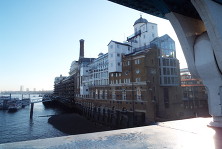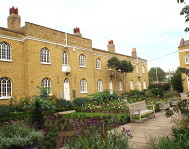








The Peckham spur ran off from the main canal at Glengall Basin. A hump remains in Glengall Road that used to be a bridge over the canal and shows the canal’s course towards Deptford and Rotherhithe. Nearby on the eastern side of Glengall Road, to the north of the canal and slightly set back was the Chubb Safe Factory. Already successful lock manufacturers, in 1835 Chubb produced and patented their first burglar resistant safe and a few years later introduced a fireproof safe. Initially safe production took place in the company’s factory in Cowcross Street but in 1868 the factory moved to Glengall Road where between 120 and 150 men were employed. Chubb safes were manufactured here until 1908 when the factory closed and safe production moved to a newly built factory in Wolverhampton that accommodated manufacture of both locks and safes. London workers were given jobs in the factory at Wolverhampton but they weren’t given much slack - the men left London on Thursday and were given the rest of the week to find accommodation in Wolverhampton for themselves and their families. On the Monday they were expected to commence work in the new factory.
Peckham Branch of the Grand Surrey Canal
The Grand Surrey Canal was indeed a grand project. It was proposed the new canal would follow a course from the River Thames at the north of Rotherhithe to Camberwell and then on to Portsmouth via Epsom. Work began in 1801 but the project ran out of money and had only got as far as Camberwell in 1810. In 1826, a branch from the main canal was opened that ran from close to the Old Kent Road for just over half a mile to Peckham.
Peckham Canal Basin in the 1930s and on the right in 2015. The Jones and Higgins shop building is in the background of both. The more decorative victorian tower was destroyed during the second world war and replaced with the plainer tower on rebuilding. The rear of the Kentish Drovers pub can be seen to the right in both photos. The library is to the left of the modern photo and Peckham Pulse to the right which was built on the site of Canal Head Warehouse where Whitten Timber was trading in 1935. The company moved to Eagle Wharf on the other side of the canal (which had been filled in by then) in 1980 where it is still based.
Edison Bell established a factory in 1903 on the other side of Glengall Road that fronted onto the northern side of the main canal, just opposite the entrance to the Peckham branch. Opposite the Edison Bell factory, on the corner of the main canal and the Peckham branch was a council depot where refuse was loaded into barges and transported to Kent.
Left: a scene from the newly opened Chubb safe factory in Glengall Road
By the late 1960s, the Surrey Docks were in decline and the canal, having fallen into discuse, had become polluted. There were incidents of children drowning and by the early 1970s the canal had been drained and filled. The Peckham spur is now a pleasant green walkway and the site of the former Edison Bell factory has been cleared to form an extension to Burgess Park. The site of the former council depot is now Glengall Wharf Garden which hosts the newly formed, community led Burgess Park Food Project.
Timber was a major import at the Surrey Commercial Docks and made up most of the traffic along the Peckham branch of the canal. It was transported in barges and pulled along the canal by horses on the towpath. As well as Whitten’s Timber, still trading at Eagle Wharf, there were many other timber yards and warehouses for other building materials.
Right: Glengall Wharf in the 1920s
Web discoveries
- UK Casino Not On Gamstop
- UK Casino Not On Gamstop
- Non Gamstop Casino
- Casinos Not On Gamstop
- Non Gamstop Casinos
- Non Gamstop Casinos
- Non Gamstop Casino
- Casinos Not On Gamstop
- Casino Sites Not On Gamstop
- Slots Not On Gamstop
- Casinos Not On Gamstop
- UK Betting Sites Not On Gamstop
- UK Casino Not On Gamstop
- Best Non Gamstop Casinos
- Betting Sites
- Non Gamstop Casino Sites UK
- Best Non Gamstop Casinos
- Non Gamstop Casino
- Casinos Not On Gamstop
- Non Gamstop Casino Sites UK
- Horse Racing Betting